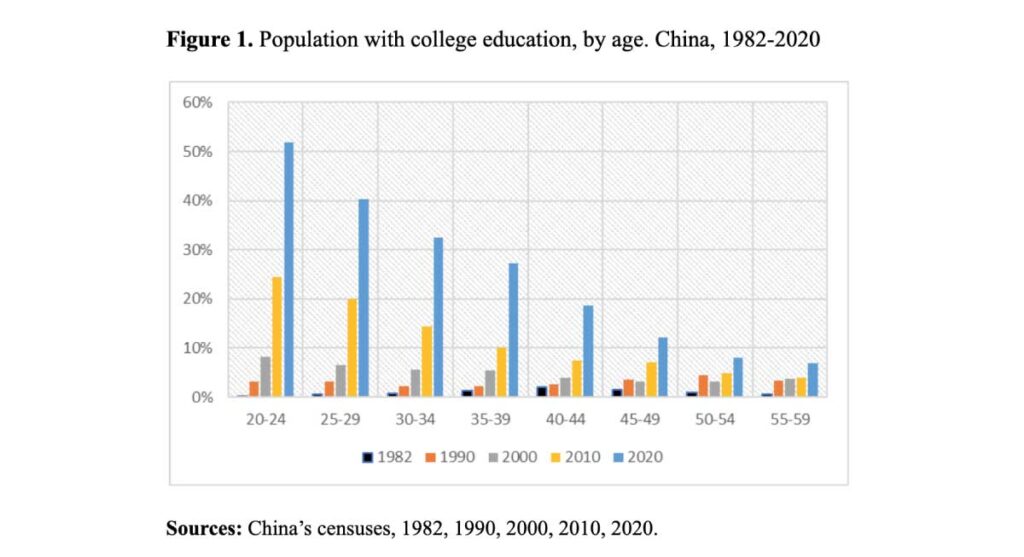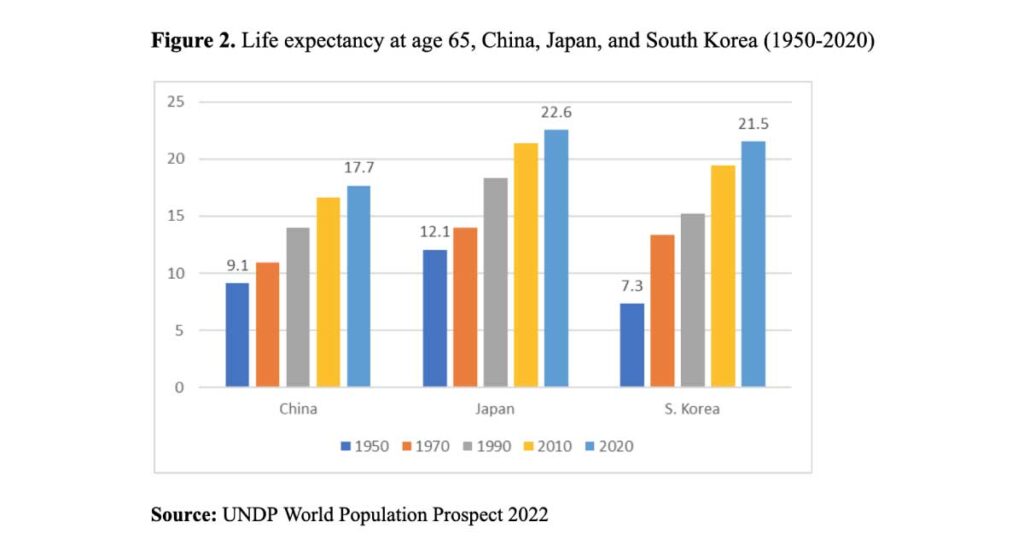
China’s population boom is over: demographic aging and decline will characterize its foreseeable future. However, according to Wang Feng, this will not entail a decrease in the standard of living of its citizens, or of China’s role in the globalized world, thanks to unparalleled improvements in education and health.
China’s onset of population decline was instantly greeted by a chorus of doomsayers. The pessimists were quick to equate this demographic turning point with the end of China’s economic growth, even the end of China’s growing global geopolitical influence. Such predictions are overly simplistic and are largely based on the premise of a population-growth driven economic development model that the world has gotten so used to in the past half century and more. Yet it takes little knowledge of economics to know that labor is only one of the key ingredients of economic output. And even labor is not just a number. China’s economic boom in the past several decades indeed benefited from a large reservoir of hard-working labor, in particular the vast flows of rural migrants to cities, but one needs to be reminded that it was institutional change that has made the feared “surplus labor” during China’s planned economy era into a highly productive labor force in the last four decades.
Should China be afraid of its population decline? Can China, and the world, adapt to a new era of global demographics featured by population aging and decline, just as they adapted to the era of population explosion? Rather than being fixated on simple population numbers, be it the size of the labor force or dependency ratios, one needs to look deeper, taking stock of the characteristics of the population, and appreciating the importance of institutional conditions that have allowed past economic successes, and that will be crucial in facing future challenges.
It’s not all about a number: new faces of the Chinese population
Thanks to its historic economic boom and social transformations, China now has the most educated young population in its history. Four decades ago, when the first post-Mao population census was taken in 1982, the picture that emerged was one of a population that was already largely literate. Yet the near universal literacy among the young at the time was just that, basic literacy. Among those aged 15 to 19, who benefited the most from the expansion of education at that time, only slightly over 40 percent had junior high school or high school education. The share was only barely 20 percent among those in their 30s. The share of the population with tertiary education was miniscule: less than 1 percent of people in their late 20s and early 30s had attended college.
China has undergone an explosive growth in higher educational opportunities. Between 1998 and 2010, annual enrollment in colleges rose more than six-fold, from barely a million to nearly seven million.1 By 2020, annual enrollment in tertiary education had reached 9.7 million.2 With an annual birth number dropping to a new low of 10.6 million in 2021, China has virtually reached tertiary education enrollment saturation. Even without further expansion, all children born in the early 2020s will be able to enroll in higher education in the future.
Vast improvements in educational attainment can be appreciated by comparisons across age groups and over the decades. As shown in Figure 1, around 10 percent of the population aged 45 to 49 in 2020 had a college education. Among the youngest age group, those aged 20 to 24, the share was five times higher, with over half already having tertiary educational attainment. Four decades ago, in this age group, the share was less than 0.25 percent and in 2010 the share was less than 25 percent. By 2020, more than a third of young people in their prime working age (20 to 34) already had tertiary education. Such a rapid shift in the educational level of the young population has transformed the Chinese economy and society in numerous fundamental ways, from work and income to consumption and participation in social and political affairs.

Health and survival
China now also has the healthiest population in its history. As China ascended from a low-income to an upper-middle income society, its population’s health profile further converged toward that of high-income countries. This convergence has come with two faces: one in the general health level of the population, and the other in disease profiles. As China’s life expectancy further increased, approaching that of high-income societies, its composition of causes of death also shifted, and is now dominated by deaths from non-communicable diseases, resembling the pattern seen in other high-income and aging populations. In contrast to earlier generations, whose early-life health risks were mostly attributable to poor nutrition, those raised during China’s age of abundance face a whole different set of risks. The term of malnutrition has acquired a new meaning in China. In the early 2010s, for instance, 244.5 million or 23.2 percent of adults aged 18 and over had hypertension, with another 435 million, or 41.4 percent having pre-hypertension, according to Chinese guidelines.3
Life expectancy is not only increasing at birth, but also at advanced ages. In China, as in the neighboring East Asian countries of Japan and South Korea, life expectancy at 65, the normal cut-off age for defining the elderly population, nearly doubled between 1950 and 2020, from 9.1 years to 17.7 years (Figure 2). Greater longevity, like educational expansion among the young, is similarly transforming the economy by enabling people to work until later ages and creating new markets to meet the needs of older adults.

Not all is gold that glitters
Recognizing these new features of the Chinese population is not to dismiss the challenges associated with China’s historical demographic shift. China will face serious fiscal challenges, which will make economic transformation and continued growth more imperative. In the first decades of the twenty-first century, public spending on health care and on pensions as a share of GDP has already more than doubled. This combined spending already accounted for more than a quarter of all government spending by 2020, or close to 10 percent of GDP.4 One study has projected that population aging alone could drive up such public spending to 20 percent of GDP by 2040, and to 23 percent by 2050.5 Increasing per capita benefits to levels commensurate with that of a high-income society could increase the share of public spending much faster, to 32 percent of GDP by 2050. In the absence of any substantial increase in government revenue, such a share would imply that the entire government revenue would have to be used for such public spending, mostly in support of an aging population.
Rather than spelling the country’s fate based on simple population numbers, however, a new economic growth model is essential for sustaining increased living standards of the population. China had an abundant supply of labor during its planned economy years, but that labor was not put to productive use. China has shifted its course of economic growth and now has the most educated and the healthiest population in its long history. The end of population growth, therefore, is by no means an automatic end of economic growth. What should be feared is not a smaller and older population. The challenges will give rise to innovation and adaptation, as history has shown us again and again.
Foot notes
- 1 China Statistical Yearbook 2010, Table 20-7. The enrollment number includes both four-year university courses and three-year vocational courses. In 2010, 3.1 million of the 6.6 million enrolled students were in three-year vocational institutions.
- 2 China Statistical Yearbook 2021, Table 21-7.
- 3 www.ahajournals.org/doi/full/10.1161/CIRCULATIONAHA.117.032380
- 4 Public spending as a share of GDP estimated by the IMF for 2020 was 35.4 percent.
- 5 Cai, Yong, Feng Wang, and Ke Shen. 2018. “Fiscal Implications of Population Aging and Social Sector Expenditure in China.” Population and Development Review 44 (4): 811–31. http://www.jstor.org/stable/45174458.
No comments:
Post a Comment